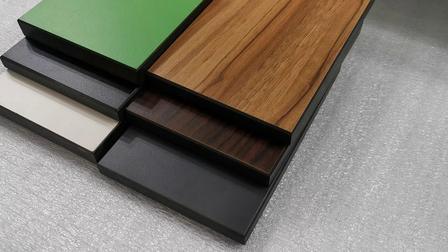Compact Laminate Board has emerged as one of the most popular modern building and furnishing materials in recent years. It’s often praised for its strength, durability, and resistance to harsh environments, making it a go-to choice for both residential and commercial projects. But is Compact Laminate Board really as good as it seems? And are there any hidden drawbacks you should consider before choosing it for your next project?
In this in-depth article, we’ll walk you through the advantages and disadvantages of Compact Laminate Board to help you decide whether it’s the right material for your needs. From its material properties to its real-world applications, we’ll leave no stone unturned.
1. What is Compact Laminate Board?
Compact Laminate Board is a type of high-pressure laminate (HPL) made from multiple layers of kraft paper infused with phenolic resin, bonded together under extreme heat and pressure. The surface is usually finished with decorative melamine paper that adds color, texture, and design.
The result is a thick, durable, and waterproof board that’s widely used in applications where toughness and aesthetic appeal are both essential. It’s commonly found in:
Toilet and shower partitions
Laboratory countertops
School and office furniture
Exterior cladding
Kitchen and bathroom wall panels

2. Is Compact Laminate Board Good?
The answer depends on your project requirements. If you need a structural material that can withstand impact, moisture, chemicals, and extreme temperatures, then yes—Compact Laminate Board is an excellent choice.
Its layered construction makes it mechanically strong, while the top layer provides visual variety and surface protection. However, like all materials, it’s not perfect. You’ll need to weigh the benefits against the limitations, especially when considering aesthetics, cost, and fabrication complexity.
3. Advantages of Compact Laminate Board
Let’s take a closer look at the many reasons why Compact Laminate Board is such a favorite in professional environments.
1. Exceptional Mechanical Strength
One of the most outstanding features of Compact Laminate Board is its high tensile strength, bending strength, and elastic modulus.
Highly impact-resistant: This makes it perfect for high-traffic environments such as public restrooms or commercial spaces.
Strong anchor pull-out resistance: Ideal for installations involving screws, bolts, or mechanical fasteners.
Verdict: Great for structural and load-bearing applications.
2. Superior Fire Resistance
Unlike many plastic-based materials, Compact Laminate Board exhibits excellent fire-retardant properties.
It doesn’t melt, drip, or explode when exposed to high temperatures.
It belongs to a high fireproof grade among organic materials.
It does not emit toxic or corrosive gases during combustion.
Verdict: A safe choice for indoor environments requiring fire safety, such as schools, hospitals, and kitchens.
3. Long-Term Stability and Low Maintenance
Thanks to its dense and non-porous surface, Compact Laminate Board is:
Highly self-cleaning: Dust and dirt do not adhere easily.
Waterproof and moisture-resistant: Perfect for humid environments like bathrooms and basements.
Fade-resistant: Retains color and finish even after prolonged use.
Verdict: An excellent low-maintenance material for both interior and exterior use.
4. Easy to Fabricate with Standard Tools
Despite its high hardness, Compact Laminate Board can be cut, drilled, sanded, and shaped using standard carbon steel or carbide tools.
Works well with CNC routers for customized patterns and cuts.
Can be easily chamfered, beveled, or rounded.
Verdict: Offers excellent versatility for customized design and fabrication.
5. Aesthetic Flexibility
Compact Laminate Boards are available in a range of colors, textures, and finishes.
Single-sided or double-sided decorative finishes.
Options include solid colors, wood grains, stone patterns, and more.
Verdict: Good for projects requiring both functionality and style.
English
Русский
العربية
Français
Español
Português
Deutsch
italiano
日本語
한국어
Nederlands
Tiếng Việt
ไทย
Polski
Türkçe
አማርኛ
Bahasa Melayu
தமிழ்
Filipino
Bahasa Indonesia
magyar
Română
Монгол
қазақ
Српски
हिन्दी
فارسی
Kiswahili
Slovenčina
Slovenščina
Svenska
українська
Ελληνικά
Suomi
Հայերեն
עברית
اردو
Shqip
বাংলা
Hrvatski
Afrikaans
Māori
සිංහල
Oʻzbekcha
latviešu
Беларуская мова
Bosanski
Български
ქართული
Lietuvių
Malti
Runasimi










